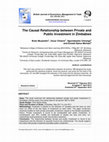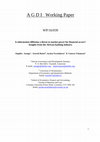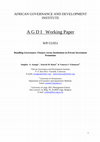Papers by Michael Enowbi Batuo

Aims: The study examines the relationship between private and public investment in Zimbabwe utili... more Aims: The study examines the relationship between private and public investment in Zimbabwe utilizing yearly time series data for the period 1967 to 2004.
Study Design: Time Series Study. Place and Duration of Study: Zimbabwe, May 2011 to July 2011.
Methodology: Emphasis is placed on the direction of causality and the long run and short run effect of the two types of investment on each other. The paper constructs empirical models for both private and public investment, based on the flexible accelerator theory. Private investment is found to be cointegrated with public investment. A cointergration and VEC models are employed to assess the long and short run
relationship existing between public and private investment.
Conclusion: The relationship between private and public investment is found to be insignificant and the direction of causality found to be unidirectional. The results support the notion that private investment precedes public investment.

Purpose
– The purpose of this paper is to investigate the impact of liberalisations policies on ... more Purpose
– The purpose of this paper is to investigate the impact of liberalisations policies on income inequality in African countries. Examining whether the liberalisations policies have affected the income distribution of everyone equally or they only assist those who are already relatively well off; leaving the poor behind. The authors also examine how they affect income distribution in the various countries within the continent, and their effect on short and long runs?
Design/methodology/approach
– First, The authors used the before and after comparison, to examine the response of the level of income inequality and the volatility of income inequality from the time that financial or trade liberalisations took place in each country. Next, the authors used the panel data techniques model for a sample of 26 African countries spanning the period 1996-2010 to investigate the effect of liberalisation policies on income distribution.
Findings
– The authors find that financial liberalisation has a levitated income-redistributive effect with the magnitude of the de jure measure (KAOPEN) higher than that of the de facto measure (FDI); that exports, trade and “freedom to trade” have an equality incidence on income distribution; and that institutional and/or political liberalisation has a negative impact and; economic freedom has a negative income-redistributive effect, possibly because of the weight of its legal component.
Practical implications
– In general, this study provides a variegated picture, findings tend to suggest that overall the reforms have increased income inequality in African countries. It would be risky to prescribe a general policy because of the diversity of the country. However, African countries’ better performance can be attributed to a combination of policies. For example avoiding the Marco price mixture of real exchange rate appreciation and high domestic interest rates; having capital controls and prudential financial regulations which would enable them to contain the negative consequence of capital flows; putting a system in place to direct export between African countries and encouraging sub regional integration agreement. The government should put in place countervailing social policies in order to withstand social coherence and smooth the adverse transition of liberalisation policies.
Originality/value
– Three main elements of originality clearly standout: first, the estimation approach used in the paper considers both short- and long-run effects of in empirical strategy; second, an exhaustive plethora of liberalisation policies (trade, financial, political and institutional are considered); and third, recent data are used to appraise second generation reforms for more updated policy implications.

This study assesses how information diffusion dampens the adverse effect of market power on the p... more This study assesses how information diffusion dampens the adverse effect of market power on the price and quantity of loans provided by a panel of 162 banks from 39 African countries for the period 2001-2011. The empirical evidence is based on three endogenity-robust estimation techniques, namely: (i) Two Stage Least Squares (2SLS), (ii) Generalised Method of Moments (GMM) and (iii) Instrumental Variable Quantile Regressions (QR). Three key results emerge. First, from the GMM results, a mobile phone penetration rate of 54.29, rising to 57 per 100 people are predicted to neutralise the adverse effect of market power on the average loan price and quantity respectively. Second, from the QR, mobile phone penetration rates of 56.20, 52.04 and 42.76 per 100 people is needed to nullify the negative effect of market power on loan quantity at the 0.10th, 0.25th and 0.90th quintiles respectively. Third, a considerably lower internet penetration rate of 9.49 per 100 people is required to counteract the negative impact of market power on loan quantity at the 0.90th quintile.

Purpose – The study extends the debate on finance versus institutions in the promotion of investm... more Purpose – The study extends the debate on finance versus institutions in the promotion of investment documented by Acemoglu and Johnson (2005), Ali (2013) and Asongu (2014). We assess the effects of various components of governance on private investment, notably: political, economic and institutional governances. Financial indicators of depth, allocation efficiency, activity and size are used.
Design/methodology/approach – An endogeneity robust dynamic system GMM estimation technique is employed. Principal component analysis is also employed to reduce the dimensions of governance variables. The empirical evidence is based on 53 African countries for the period 1996-2010.
Findings – The findings provide support for the quality of governance as a better determinant of private investment than financial intermediary development. Moreover, the evidence of finance and governance as substitutes in their impact on investment implies that good governance fuels private investment and this positive impact is stronger in nations with less developed financial systems. This finding is consistent with Ali (2013) and contrary to the results of Asongu (2014c).
Practical implication – Policy measures for fighting involuntary and voluntary surplus liquidities are discussed. The paper provides additional support for the need of strengthening governance institutions to promote investment on the one hand and fighting financial allocation inefficiency by mitigating surplus liquidity issues on the other hand.
Originality/value – The paper extends the debate on the substitution of finance and institutions in the promotion of private investment.
This paper present empirical evidence on how financial development is related to income distribut... more This paper present empirical evidence on how financial development is related to income distribution in a panel data set covering 22 African countries for the period between 1990 to 2004. A dynamic panel estimation technique (GMM) is employ and the findings indicate that income inequality decrease as economies develop their financial sector, which is consistent with the bulk of theoretical and empirical research. The result also confirm that educational attainment play a significant role in making income distribution more equal. We also find no evidence supporting the Greenwood-Jovanovic hypothesis of an inverted-U-shaped relationship between financial sector development and inequality.
MPRA Paper, Jan 1, 2009
Abstract: The objective of this paper is to study the interactions between economic liberalisatio... more Abstract: The objective of this paper is to study the interactions between economic liberalisation, political liberalisation and financial development in African countries. More specifically, we seek to establish the impact of economic, political and institutional ...
This paper studies the evolution of the foreign trade specialization in manufacturing sectors of ... more This paper studies the evolution of the foreign trade specialization in manufacturing sectors of South Africa, Algeria, Nigeria and Egypt. These four countries, the so-called SANE, are recently viewed as Africa's best chance of producing an economic bloc comparable to the BRIC economies of Brazil, Russia, India and China. Using data on trade flows since mid-1970s, the results show that the SANE group has experienced few changes in its trade structure, which is still based on low-technology and slow-growth world demand sectors. The degree of persistence in the specialization model is higher in the case of Algeria and Nigeria, where the dependence on products based on natural resources is stronger.
MPRA Paper, Jan 1, 2008
This paper deals with the effects of telecommunications on the economic growth in African countri... more This paper deals with the effects of telecommunications on the economic growth in African countries. The telecommunications sector became a vital sector during the era of the economic reform that has been characterising the continent. We investigate empirically ...
The aim of this paper is to provide new empirical evidence about the determinants of per capita i... more The aim of this paper is to provide new empirical evidence about the determinants of per capita income in African countries, with particular attention to the affects of governance institutional quality and sub regional integration on income level. We use a sample of 49 countries from the period 1996-2004 and the Generalized Method of Moments Estimation model for dynamic panel, proposed by Arellano and Bond (1991). The results show that African regional groups with better institutions, higher degrees of regional integration cooperation, higher rates of investment in human capital and lower rates of population growth, show a higher level of per capita income.










Uploads
Papers by Michael Enowbi Batuo
Study Design: Time Series Study. Place and Duration of Study: Zimbabwe, May 2011 to July 2011.
Methodology: Emphasis is placed on the direction of causality and the long run and short run effect of the two types of investment on each other. The paper constructs empirical models for both private and public investment, based on the flexible accelerator theory. Private investment is found to be cointegrated with public investment. A cointergration and VEC models are employed to assess the long and short run
relationship existing between public and private investment.
Conclusion: The relationship between private and public investment is found to be insignificant and the direction of causality found to be unidirectional. The results support the notion that private investment precedes public investment.
– The purpose of this paper is to investigate the impact of liberalisations policies on income inequality in African countries. Examining whether the liberalisations policies have affected the income distribution of everyone equally or they only assist those who are already relatively well off; leaving the poor behind. The authors also examine how they affect income distribution in the various countries within the continent, and their effect on short and long runs?
Design/methodology/approach
– First, The authors used the before and after comparison, to examine the response of the level of income inequality and the volatility of income inequality from the time that financial or trade liberalisations took place in each country. Next, the authors used the panel data techniques model for a sample of 26 African countries spanning the period 1996-2010 to investigate the effect of liberalisation policies on income distribution.
Findings
– The authors find that financial liberalisation has a levitated income-redistributive effect with the magnitude of the de jure measure (KAOPEN) higher than that of the de facto measure (FDI); that exports, trade and “freedom to trade” have an equality incidence on income distribution; and that institutional and/or political liberalisation has a negative impact and; economic freedom has a negative income-redistributive effect, possibly because of the weight of its legal component.
Practical implications
– In general, this study provides a variegated picture, findings tend to suggest that overall the reforms have increased income inequality in African countries. It would be risky to prescribe a general policy because of the diversity of the country. However, African countries’ better performance can be attributed to a combination of policies. For example avoiding the Marco price mixture of real exchange rate appreciation and high domestic interest rates; having capital controls and prudential financial regulations which would enable them to contain the negative consequence of capital flows; putting a system in place to direct export between African countries and encouraging sub regional integration agreement. The government should put in place countervailing social policies in order to withstand social coherence and smooth the adverse transition of liberalisation policies.
Originality/value
– Three main elements of originality clearly standout: first, the estimation approach used in the paper considers both short- and long-run effects of in empirical strategy; second, an exhaustive plethora of liberalisation policies (trade, financial, political and institutional are considered); and third, recent data are used to appraise second generation reforms for more updated policy implications.
Design/methodology/approach – An endogeneity robust dynamic system GMM estimation technique is employed. Principal component analysis is also employed to reduce the dimensions of governance variables. The empirical evidence is based on 53 African countries for the period 1996-2010.
Findings – The findings provide support for the quality of governance as a better determinant of private investment than financial intermediary development. Moreover, the evidence of finance and governance as substitutes in their impact on investment implies that good governance fuels private investment and this positive impact is stronger in nations with less developed financial systems. This finding is consistent with Ali (2013) and contrary to the results of Asongu (2014c).
Practical implication – Policy measures for fighting involuntary and voluntary surplus liquidities are discussed. The paper provides additional support for the need of strengthening governance institutions to promote investment on the one hand and fighting financial allocation inefficiency by mitigating surplus liquidity issues on the other hand.
Originality/value – The paper extends the debate on the substitution of finance and institutions in the promotion of private investment.
Study Design: Time Series Study. Place and Duration of Study: Zimbabwe, May 2011 to July 2011.
Methodology: Emphasis is placed on the direction of causality and the long run and short run effect of the two types of investment on each other. The paper constructs empirical models for both private and public investment, based on the flexible accelerator theory. Private investment is found to be cointegrated with public investment. A cointergration and VEC models are employed to assess the long and short run
relationship existing between public and private investment.
Conclusion: The relationship between private and public investment is found to be insignificant and the direction of causality found to be unidirectional. The results support the notion that private investment precedes public investment.
– The purpose of this paper is to investigate the impact of liberalisations policies on income inequality in African countries. Examining whether the liberalisations policies have affected the income distribution of everyone equally or they only assist those who are already relatively well off; leaving the poor behind. The authors also examine how they affect income distribution in the various countries within the continent, and their effect on short and long runs?
Design/methodology/approach
– First, The authors used the before and after comparison, to examine the response of the level of income inequality and the volatility of income inequality from the time that financial or trade liberalisations took place in each country. Next, the authors used the panel data techniques model for a sample of 26 African countries spanning the period 1996-2010 to investigate the effect of liberalisation policies on income distribution.
Findings
– The authors find that financial liberalisation has a levitated income-redistributive effect with the magnitude of the de jure measure (KAOPEN) higher than that of the de facto measure (FDI); that exports, trade and “freedom to trade” have an equality incidence on income distribution; and that institutional and/or political liberalisation has a negative impact and; economic freedom has a negative income-redistributive effect, possibly because of the weight of its legal component.
Practical implications
– In general, this study provides a variegated picture, findings tend to suggest that overall the reforms have increased income inequality in African countries. It would be risky to prescribe a general policy because of the diversity of the country. However, African countries’ better performance can be attributed to a combination of policies. For example avoiding the Marco price mixture of real exchange rate appreciation and high domestic interest rates; having capital controls and prudential financial regulations which would enable them to contain the negative consequence of capital flows; putting a system in place to direct export between African countries and encouraging sub regional integration agreement. The government should put in place countervailing social policies in order to withstand social coherence and smooth the adverse transition of liberalisation policies.
Originality/value
– Three main elements of originality clearly standout: first, the estimation approach used in the paper considers both short- and long-run effects of in empirical strategy; second, an exhaustive plethora of liberalisation policies (trade, financial, political and institutional are considered); and third, recent data are used to appraise second generation reforms for more updated policy implications.
Design/methodology/approach – An endogeneity robust dynamic system GMM estimation technique is employed. Principal component analysis is also employed to reduce the dimensions of governance variables. The empirical evidence is based on 53 African countries for the period 1996-2010.
Findings – The findings provide support for the quality of governance as a better determinant of private investment than financial intermediary development. Moreover, the evidence of finance and governance as substitutes in their impact on investment implies that good governance fuels private investment and this positive impact is stronger in nations with less developed financial systems. This finding is consistent with Ali (2013) and contrary to the results of Asongu (2014c).
Practical implication – Policy measures for fighting involuntary and voluntary surplus liquidities are discussed. The paper provides additional support for the need of strengthening governance institutions to promote investment on the one hand and fighting financial allocation inefficiency by mitigating surplus liquidity issues on the other hand.
Originality/value – The paper extends the debate on the substitution of finance and institutions in the promotion of private investment.